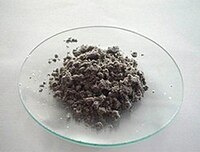
Photo from wikipedia
Abstract The susceptibility to hydrogen embrittlement and diffusion behavior of hydrogen were evaluated in interstitial nitrogen-alloyed austenitic steel QN1803 and 304 and 316 L stainless steels. The amount of transformed martensite… Click to show full abstract
Abstract The susceptibility to hydrogen embrittlement and diffusion behavior of hydrogen were evaluated in interstitial nitrogen-alloyed austenitic steel QN1803 and 304 and 316 L stainless steels. The amount of transformed martensite and the activation energy of hydrogen diffusion were revealed via electron backscattering diffraction and thermal desorption spectroscopy. The austenite stability of QN1803 during the deformation process was higher than that of 304 and 316 L. However, the hydrogen content of QN1803 was high because of the small grain size and low activation energy of hydrogen diffusion. For the stable QN1803 and 316 L austenitic steels, martensite had no evident harmful effect because of its discrete distribution. A planar dislocation slip was observed in QN1803 during deformation. Hydrogen charging enhanced dislocation mobility, leading to severe strain localization. Thus, the severe strain in QN1803 promoted microcracking.
Journal Title: International Journal of Hydrogen Energy
Year Published: 2021
Link to full text (if available)
Share on Social Media: Sign Up to like & get
recommendations!